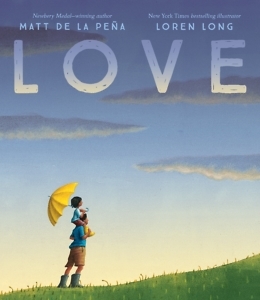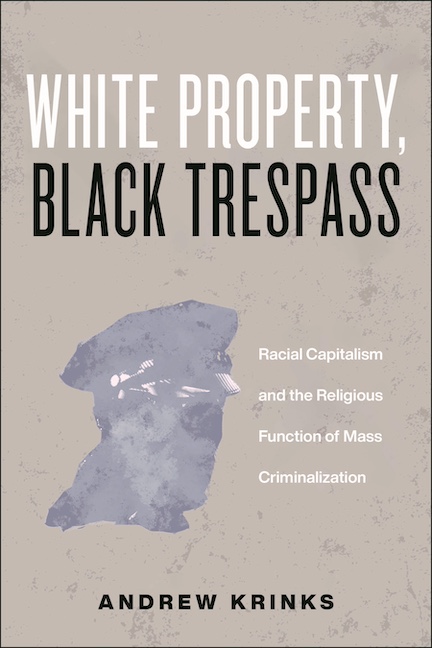A Labor of Love
Matt de la Peña and Loren Long discuss their new picture book, a tribute to love
Love is a daunting subject to write about, the topic of many brilliantly-spun novels and many banal pop ballads. So it was with care, time, and attention that Newbery Medal-winning author Matt de la Peña crafted his meditation on love, the subject of his newest picture book. Titled simply Love, it is illustrated with a powerful emotional resonance by New York Times bestselling artist Loren Long. Thoughtful and tender, Love pays tribute to unconditional love, familial love, and even love for one’s own face in the mirror.

Wisely, though, de la Peña knew better than to celebrate the light of love, which he does in much of the book’s lyrical prose, without also honoring its occasional darkness. In an essay for Time magazine just this month, he argues for the value of “emotionally complex” picture books and asks adults not to shield children from darkness. “I can’t think of a safer place to explore complex emotions for the first time than inside the pages of a book,” he writes, than “while sitting in the lap of a loved one.” Love acknowledges poverty, homelessness, tragedy (on both the personal and national levels), and family strife, with both author and illustrator stressing the healing power of love: “Stars shine long after they’ve flamed out,” one elderly woman in the book tells a child who has just witnessed a fire, “and the shine they shine with is love.”
Both author and illustrator answered questions via email about the joys and challenges of creating a picture book about this crazy little thing called love.
Chapter 16: Matt, how long did it take to draft what amounts to an ode to love itself? Were there many iterations?
Matt De la Peña: I probably revised Love a hundred times over the course of several months. I didn’t even understand what I was trying to do until close to the end. So, yes, there were many iterations. And once I finally got the “story” right, I had to then get the music right. When you only have eight hundred or so words to work with, even a single missed note really stands out. People would be surprised how long it takes to get a picture book text right.

Chapter 16: Can you talk about deciding to address some scary parts of childhood in your text—people who may let them down, traumatic world events on television, etc. I love that you did this—and the way you subtly acknowledge that sometimes there are no answers. (But there is love.)
De la Peña: About halfway through my process, I sensed there was something missing in the text. I had what I believed was an uplifting exploration of love in the life of a child, but it felt strangely hollow. I put the poem away for a while and worked on other projects, and when I came back to Love with fresh eyes, I quickly realized my mistake. I had failed to even acknowledge any sense of adversity.
I decided I had to be more honest with my reader. There are many wonderful picture books out there that are one hundred percent reaffirming—I read some of them to my own daughter—but to get this particular book right I had to explore the role adversity plays in a child’s journey through love.
Chapter 16: Loren, can you talk about the multi-media style of art you chose for this one—the mixture of acrylics, pencils, and printmaking?
Loren Long: In an ongoing effort to push myself as an artist, I took a monotype printmaking class a couple years back. I wanted to play around with the lack of control that happens when you apply ink to a glass plate, manipulate the ink, and press it onto paper—and one day, perhaps, to use the technique to make a picture book. Something about the tender balance of truth and reassuring hopefulness in Matt’s text for Love grabbed at me and inspired me to take a risk and try something new.
For each image in Love, I made as many as five or six different prints on a press, cut them out, glued the pieces down, and painted into the collage with acrylic paint and some pencils. It was both terrifying and exhilarating at the same time.
 Chapter 16: The manuscript must have offered so much for an illustrator to run with. What were some of the joys of interpreting Matt’s words into the illustrations we see here?
Chapter 16: The manuscript must have offered so much for an illustrator to run with. What were some of the joys of interpreting Matt’s words into the illustrations we see here?
Long: Matt’s manuscript was indeed a challenge. For each moment in the poem, there were multiple directions I could have chosen to illustrate. It gave me lots of freedom to interpret and create a different narrative within the framework of each turn of the page. I think the most exciting part for me was creating visuals for the darker places in the text. When a child looks at those pages and hears those words, I want them to see in my art that they matter, that they are not alone, and that even in the scary parts of life there is hope and love.
Chapter 16: Matt, what was it like for you to first see Loren’s art for this one?
De la Peña: I was blown away when I saw Loren’s art for the first time. The word that came to mind was “brave.” He took a real risk with the form (trying a completely new technique), but he was also incredibly brave in terms of content. He allowed the heavier parts of the text to be heavy, while simultaneously adding a kind of comfort. The art in this book is just amazing to me.
Chapter 16: Loren, can you talk about your palette choices for this one—the deep, rich blues and purples and greens that dominate?
Long: Much of this palette was a result of the new technique that I worked in. The oil-based inks provide rich, vibrant colors. My goal was to let the spontaneity of the process guide the resulting image as much as possible and leave those raw colors sitting on the surface of the paper without overworking them with my paint brush. As I pulled each inked-up plate through the press, I loved how the colors sang with intensity and richness, as they settled into the rag surface of the paper.
Chapter 16: What’s next for each of you?
De la Peña: I have a couple of YA novels coming in the next year, as well as a second picture book with Christian Robinson, called Carmela Full of Wishes.
Long: After Love, I’m making a book out of a funny old folk song. I’m also working on a beautiful picture book text by Julie Fogliano, as well as writing some things of my own.

Julie Danielson, a former school librarian, blogs at Seven Impossible Things Before Breakfast and writes about picture books for Kirkus Reviews, BookPage, and the Horn Book. Her first book, Wild Things! Acts of Mischief in Children’s Literature, was published in 2014.





